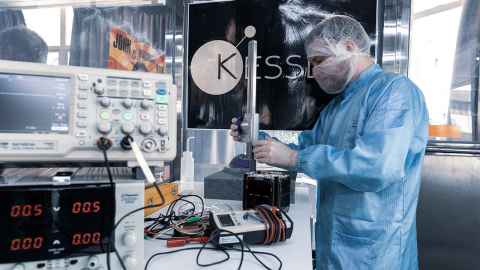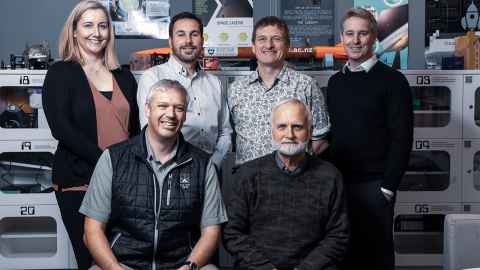University of Auckland space cadets taking their mission seriously
25 November 2019
There’s no shortage of enthusiasts – students and teachers alike – keen to be involved in space research at the University of Auckland. Owen Poland meets some of those launching themselves into the final frontier.

There’s something about firing a miniature satellite the size of a cube tissue box into space that captures the imagination, but few would have imagined that a satellite design competition would help propel the University of Auckland to the forefront of space research in New Zealand.
Launched in 2016, the extracurricular Mission Proposal Competition organised by the Auckland Programme for Space Systems (APSS) has attracted more than 400 enthusiastic undergraduates despite the absence of any course credits.
“I just love space, who doesn’t?” says science student Julianne McCoun, a member of the winning 2019 Team Koios, whose aim is to create an open-source platform for future competitors. “It really got me excited about being able to inspire and influence the next generation.”
As a member of Team Kessler, which won the 2018 competition for its mission to create an electrodynamic tether that captures and removes space junk, engineering student Jonathon Mace is rapt to be part of a programme that incubates start-ups and “throws people out into the space ecosystem”.
APSS Director Jim Hefkey says because we don’t know what the future holds, the competition is designed to expose them to new and complex problems. “Space is an excellent analogue for that.”
The event requires multidisciplinary teams to identify a societal need and design a solution using a 10 x 10 x 10cm satellite called a CubeSat. The resulting collaboration encourages the development of transferable skills Jonathon is grateful for. “I’m picking up so much that I just don’t have the opportunity to learn through my normal degree pathway.”
As well as breaking down barriers, Julianne says the multi-faculty approach encourages diversity of thinking – even if you don’t get along with everyone on your team. “You still have to work with them and that’s a really important skill in life.”

What sets Auckland’s CubeSat challenge apart from similar events overseas is the degree of testing involved before a satellite is launched. Around half the CubeSats sent into space are never heard from again and become “expensive rocks”, according to APSS co-founder Professor Richard Easther. “One of the things we’ve worked hard on is making sure that the payload has been tested and we understand how it’s going to behave.”
Expected to be launched in early January, the APSS-1 Waka Amorangi o Aotearoa, designed by Team QuakeTec, is the first mission-ready CubeSat. It will test whether ionospheric disturbances can predict earthquakes. As the launch provider, Rocket Lab founder Peter Beck says it’s great to see students doing really good spacecraft work. “We’ll be supporting the University, making sure we can get students’ spacecraft up in orbit and I think it’s going to be really exciting to see what comes out.”
The APSS has also inspired alumni to get involved. Having graduated with a masters in mechanical engineering in 1962, Dr Neil Paton left for the United States to pursue a career in the space programme and has now resolved to do whatever he can to support what he says are “truly innovative” experiments here.
“Now students in Auckland can aspire to dreams and goals in space research that are almost without limit and never have to leave New Zealand,” says Neil.
In 2018, Team Koios were the inaugural winners of the Neil and Louise Paton Family Award after the APSS received a major gift from the Patons.
That opportunity isn’t lost on Anastasiya Kiddle from Team Kessler, who sees space as “literally the next frontier”, providing “all these chances for us”. Likewise, Team Koios leader Matthew White believes New Zealand’s space ecosystem is just ramping up and in a few years “it’s going to be just crazy exciting because we’re going to have so many people involved”.
Although the APSS is primarily designed to increase student engagement, it has also boosted collaboration at an academic level and Richard Easther says the CubeSat challenges have grown expertise and driven organic change among staff.
“It’s got people talking to each other in ways that might not have been the case.”
The extracurricular teaching programme has also been the basis for the fledgling Te Punaha Atea – the Auckland Space Institute at the University – which is developing space satellite missions to service New Zealand’s strategic, scientific and economic goals. Likened by Dean of Engineering Professor Nic Smith to “a lightning rod” for the capability that exists across the University, the Institute has been turbo-charged with the appointment of Professor Guglielmo Aglietti as its inaugural Director.
Guglielmo is internationally recognised as a pioneering space engineer and principal investigator behind the RemoveDEBRIS mission that deploys state-of-the-art technologies to clear space junk.
As well as offering dedicated student programmes and providing a much-needed pipeline of graduates, Te Punaha Atea will serve as a hub to manage connections with local and international partners – and nurture collaborative links with key commercial partners, including Rocket Lab.

“We’re eager to build New Zealand’s capabilities and we want to be the flagship that brings that expertise together,” says Catherine Qualtrough, Research Operations Co-ordinator.
Work is also well under way on projects funded primarily by MBIE and the Science for Technological Innovation National Science Challenge (SfTI) that target leading-edge technology developments, in collaboration with research partners in Australia, Germany and the US led by aerospace engineer Dr John Carter from the Faculty of Engineering and astrophycicist Dr Nick Rattenbury from the Faculty of Science, investigators are looking into the use of Synthetic Aperture Radar to potentially monitor New Zealand's Exclusive Economic Zone from space.
They're also working on developing electric propulstion systems for miniature satellites and the use of light-metals technology to cost-effectively recover samples from satellites to enable more space science.
Two longer-term goals involve looking for life in the clouds of Venus and pointing telescopes into outer space. John doesn’t see New Zealand launching a rocket to Mars in the next five years.
“But we might be able to make an instrument that somebody pays us hundreds of millions of dollars for that makes it to Mars.”
For Nick, the ultimate goal is New Zealand’s first space telescope. “That’s what I want to do, to do astronomy. But to get there, I have to go through a whole bunch of engineering first. I hope I get it done before my career ends.”
This story first appeared in Spring 2019 Ingenio.
Contact Ingenio.